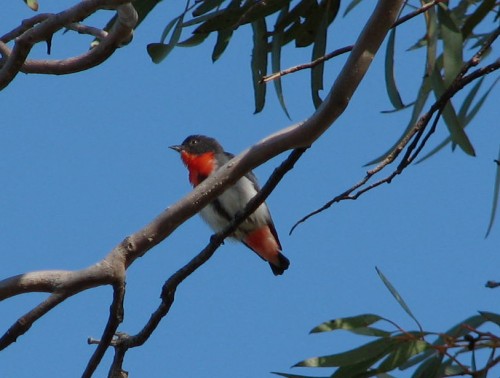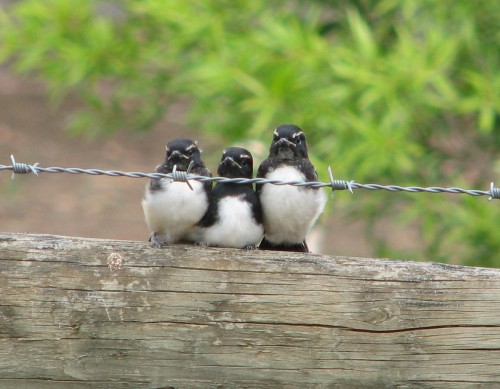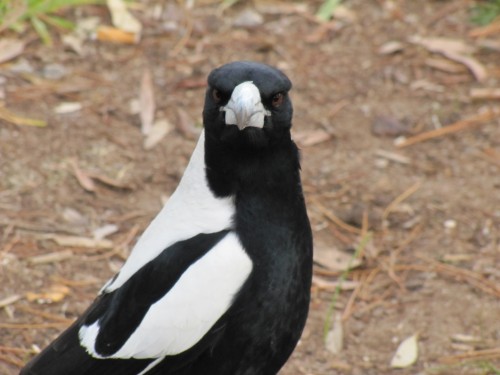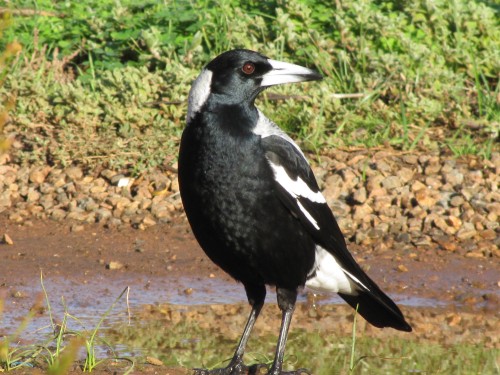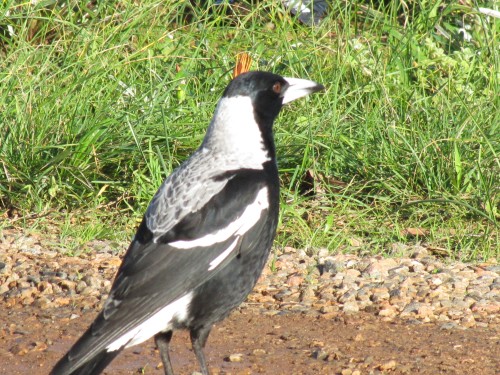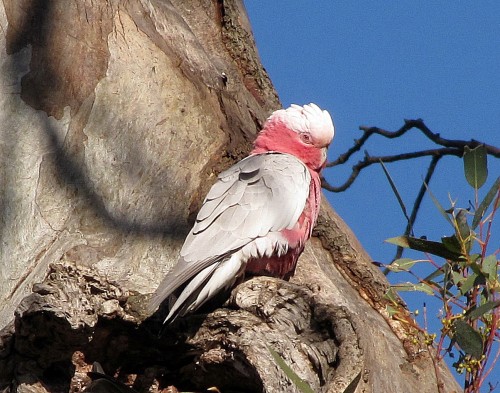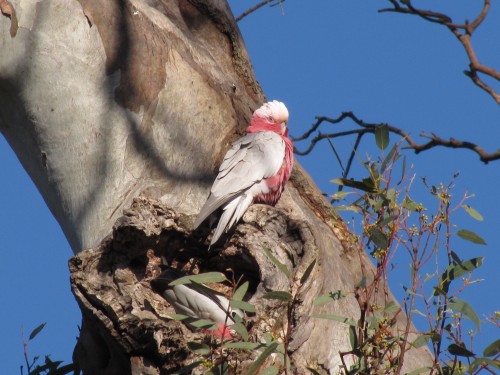A Mistletoebird pays a quick visit
Yesterday my wife and I were taking a short break from the jobs we had been doing. Sitting on our back veranda we were enjoying the lovely sunny spring weather we have had this week. It was afternoon tea time and we were enjoying a well deserved cup of tea. The back veranda has been a bit of a mess over the winter months and the weather has been too cold to spend too much time cleaning it up. Now that the spring weather is here we had a renewed enthusiasm for being outside.
While we sat there we enjoyed the constant parade of birds hopping around in the garden nearby. Many others were calling and we enjoy trying to identify them by call alone, a good way of honing one’s identification skills. Our resident Superb Fairy-wrens entertain us every day, as do the Mallee Ringneck parrots, the Eastern Rosellas and the Galahs. We can’t work out if the Galahs are actually nesting or not. The Spotted Turtledoves often join in the chorus and in recent days we have had the delight of Peaceful Doves also hanging around near the house.
As we sat there we were delighted to have a female Mistletoebird fly in and alight on a bush in full view just three metres from us. We were able to see the soft, dull grey colours of the feathers on her back, a stark contrast with the blue-black feathers of the male (see photo above). I didn’t have the camera handy, and the bird flew off after less than a minute, so I have shared a photo of the male taken some years ago. I do have one photo of the female, but unfortunately it is not in focus. Sigh.
I cannot categorically say that this is a resident species in our garden and on our 5 acre property, but it is certainly a regular visitor. I hear its call almost every week. Many years ago this was the first species to nest in one of the trees we planted after moving here. There may have been other species before it, but this was the first one we positively recorded doing this. The nest is a delicate pear-shaped container with a small entrance near the top. It is made primarily from spiders’ webs, small leaves, lichen and other soft materials, and hangs from small twigs or leaves. They are just coming into their breeding season, so I need to keep an eye open for a nest. This species is found throughout mainland Australia except in the driest regions. It is not present in Tasmania.
Further reading:
- Beautiful Mistletoebird
- Great Birding Moments #3
- If you click on the name of any of the bird species mentioned in the text above, you can go to other articles about that species.
It’s nesting time again
It’s that time of year again in Australia – spring nesting season.
Birds everywhere are making nests, sitting on eggs in nests or feeding young just out of the nest. In southern Australia – the region I am most familiar with – the “spring” nesting season stretches from the winter months of July and August, through the entire season of spring (September – November) and even well into summer (December – January).
Having confused all of my overseas readers I should explain three things:
- Most of the breeding occurs in the spring months.
- Some species – like our honeyeaters – will nest multiple times, raising 2 or more broods a season.
- Some species will even raise as many as five broods over a six month period.
Being late September nesting is in full swing here on our 5 acre (2 hectare) property in Murray Bridge, South Australia. The following is a quick annotated list of those species I have observed in the breeding mode in recent weeks:
Willie Wagtail: our resident birds have been very quiet and I suspected that they had a nest somewhere but I only found it yesterday. It contained two eggs. The photo above shows a fluffy family of Willie Wagtails just out of the nest a few years ago.
New Holland Honeyeater: last week I saw two parent birds fussing over and feeding two fledglings just out of the nest and barely able to flutter, let alone fly.
Red Wattlebird: I saw one bird sitting on a nest high in one of our trees but haven’t checked it in recent days. Other wattlebirds in our garden are being bossier than usual, so I guess that there are young around somewhere.
House Sparrow (introduced species): they always seem to be mating and nesting, so nothing unusual there.
Common Starling (introduced): the resident dozen or so birds all seem to have taken up occupation of a number of tree hollows in our mallee scrub, but I haven’t yet heard the persistent calls of the nestlings begging to be fed.
Mallee Ringneck parrots: our resident birds were feeding young a month or so ago, and I have seen them constantly investigating a tree hollow. Earlier this week we saw two of them mating, so the next brood could be on the way soon.
Cuckoos: I haven’t seen any cuckoos yet this season but I have heard Horsfield’s Bronze-cuckoos calling several times, so they could possibly be nesting too.
Galah: I’m not sure what our Galahs are doing. They come to a hollow in an old growth mallee tree near our clothes line and enter the hollow every day but nothing else seems to be happening. This has happened now for several years so I will just have to keep an eye on proceedings.
Australian Magpie: this is a really puzzling one. The resident magpies showed all the right activities a few months ago when they defended their territory but since then everything has gone quiet. We daily see several birds feeding around the garden and in the paddock, but I have yet to locate a nest. Very strange.
I have highlighted just 9 species in this article. Over the last 30 years I have observed many more species either breeding, or feeding young, on our property. I am quite confident that there would be other species currently nesting somewhere here, possibly including:
- Grey Shrike-thrush
- Common Blackbird (introduced)
- Spotted Turtledove (introduced)
- Crested Pigeon
- Yellow-rumped Thornbill
- Weebill
- Spotted Pardalote
- Striated Pardalote
- Mistletoebird
- White-plumed Honeyeater
- Spiny-cheeked Honeyeater
- Singing Honeyeater
- Little Raven
- Pacific Black Duck (they bring the ducklings to our swimming pool!
- Superb Fairy-wren
- Australian Magpie-lark
- Grey Butcherbird
Further reading:
Click on the following article headings to read about successful breeding attempts in past years:
- We have baby Willie Wagtails
- New Holland Honeyeater nest
- Red wattlebirds with young
- House Sparrows eating berries
- Very Common Starlings – nesting
- Mallee Ringnecks nesting
- Horsfield’s Bronze-cuckoo
- Possible Galah nesting attempt
- Baby Magpie – this is the most popular article on this site with nearly 500 reader comments.
The problem of swooping magpies
It’s magpie swooping time again.
At this time of year people in many places around Australia are ducking for cover. It is magpie swooping time again. Around July and onwards our Australian Magpies start building or refurbishing their nests ready for the breeding season. Once the female has laid to eggs she is the only one to hatch them. Meanwhile, the male keeps guard over his territory.
Territorial
This species is highly territorial and disputes over their patch are hotly contested. On our five acre (2 hectare) property we have three intersecting territories, so the conflict can sometimes get quite boisterous. Once nesting commences, these bird wars calm down. You could say that they are real life “angry birds”.
Attacks
The fighting doesn’t always end there, however. While the female is sitting on the eggs, or the young are being fed while still in the nest, the male can be very aggressive in guarding his territory against anything, or anyone, he sees as a threat to the success of his progeny. Animals – including dogs, cats, foxes – other birds, walkers, gardeners, joggers and anyone misguided enough to venture within a hundred metres or so of the nest are all fair targets. Cyclists are a particular object of attack.
Damage
The male magpie will usually wait until the target has passed by, and will then attack from behind, a swift, smooth, nearly silent swoop aimed at the head. A swoosh of the wings and a few snaps of the beak from less than a metre behind is often the only warning one gets. By then it is too late. If contact is made the result can be both frightening and bloody. Their sharp beak can inflict a nasty break in the skin, and in a worst case scenario they have been known to damage an eye.
Preventing being swooped
So – what can one do to prevent getting swooped? I recently read this great list which was published here in South Australia in Weekend Plus: a digital magazine for seniors.
“We do need to take care around them because they have sharp beaks and claws and if they make contact, they can draw blood.
“The good news is that swooping season only lasts about six weeks, beginning when the eggs hatch and finishing when the young birds leave the nest.
“The best way to avoid being swooped is to change your route if possible, as they’ll only swoop within 50m of their nests.”
More tips for surviving the spring swoop
- Avoid making eye contact with magpies.
- Walk, don’t run past their nests.
- Travel in groups where possible as swooping birds generally target individuals.
- Carry an open umbrella or wear sunglasses and a broad-brimmed hat.
- If you’re riding a bike, walk your bike through magpie territory or attach a flag to the back that is taller than your head.
- Don’t wave your arms or shout – this just proves you are a threat to the nest.
- If you know of a swooping magpie, put up a sign to warn others.
Further reading:
- Do Blackbirds swoop? How to deal with aggressive birds.
- A bit on the nose – a humorous close encounter with a bird
- Magpies behaving badly
- Bird wars
- Aggressive bird behaviour in the garden
Mallee Fowl in the Murraylands region
Nearly 9 years ago I wrote the following article:
A few days ago I had a new comment on this post with an observation about the lack of Mallee Fowl in the park. Here is the comment:
I visited Ferries MacDonald CP on Tuesday 23 June and noticed that 1080 poison baits have been used to attempt to eradicate foxes. There were signs on the boundary fences warning dog owners. I did not see any mallee fowl despite spending several hours wandering through and around the park. I suspect there are none left unfortunately. I last visited the park thirty years ago and saw one there at that time as well as a few active nests. The park is not large and is surrounded by farmland. It may be too small to provide a suitable habitat for mallee fowl. I hope I am wrong. David.
The following was my reply:
As a result of your comments my wife and I briefly visited the park last Sunday. We actually spent more time in the nearby Monarto Conservation Park.
The poison baits programme has been ongoing for quite some time, probably years, and is a common practice in many parts of Australia. I have walked through both of these parks on numerous occasions over the last 30 years (I live in Murray Bridge) and have only ever seen Mallee Fowl on one occasion, two together on the side of the road near where the two roads intersect.
Last Sunday I checked on one of the Mallee fowl nest mounds that I have checked regularly since finding it some 10 years ago. It was active as recently as about 3 years ago, but sadly it now looks as if it hasn’t been used in at least the last two years, possibly longer. I know of at least 3 other mounds but I would be hard pressed to find them now. Extensive surveys of nesting sites have been conducted but I do not know when the last was done, nor the results.
On a related matter, national parks rangers were, I believe, removing eggs from the active nests, taking them to Monarto Zoo for hatching artificially and then returning the birds to the wild, including this park. Some birds were released with radio tracking devices and the failure rate was near to 100%, probably due to fox predation.
On a brighter note, a friend who lives less than a kilometre from the park saw a Mallee Fowl wandering through his garden only last year, so there is hope that some are surviving in this area. There are also regular reports of sightings east of the Murray River, and from the south east parts of the state.
Further reading:
- Ferries-McDonald Conservation Park – now updated with new information
- Mallee Fowl – the incubator bird
- What kind of duck was that? An exciting observation of Mallee Fowls
- Birds of Monarto Conservation Park
